Help
Use these pages to view Du Chemin’s chansons nouvelles in different ways and combinations.
Work View
The Work View shows the complete literary text of a single chanson, arranged phrase by phrase, along with information about rhyme scheme of the text.

Just below the text is a rendering of the piece’s musical notation. There is no need to install special software.
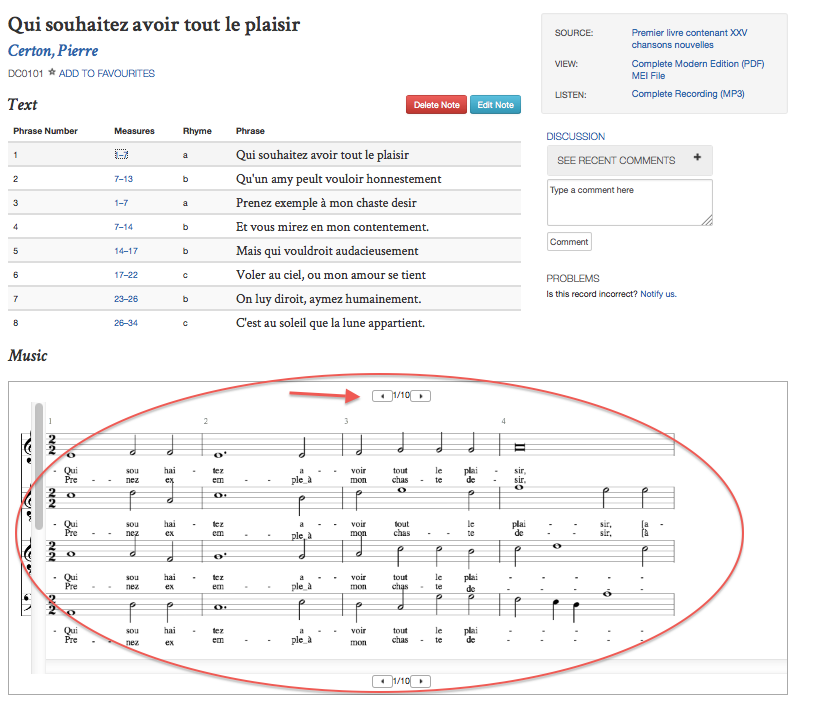
When viewing the list of phrases or observations, you can click on the measure numbers to see the music notation for an individual phrase in a floating viewer.
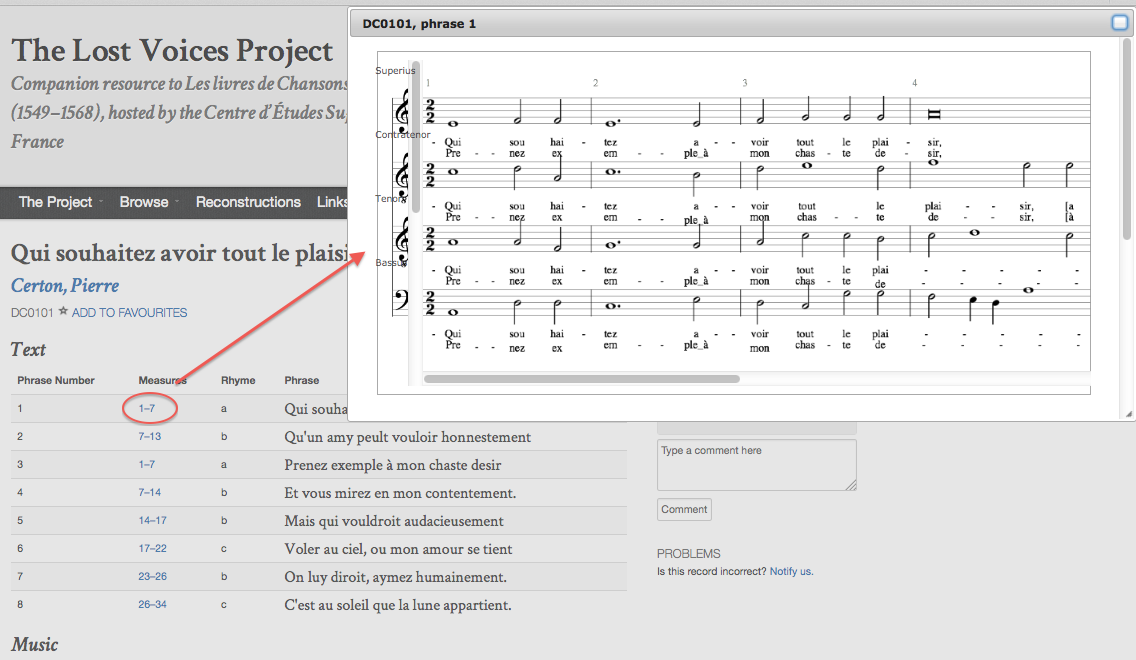
See Favourites, Notes, and Public Discussions for information on keeping track of and writing about pieces. See Modern Editions, Sound Recordings, and Facsimiles for a guide to those resources.
Variant readings and emendations
A number of pieces have variant readings in other sources, or have had emendations made to them by an editor. If a piece has variant readings or emendations, a human-readable summary will appear below the music in the piece’s Work View.
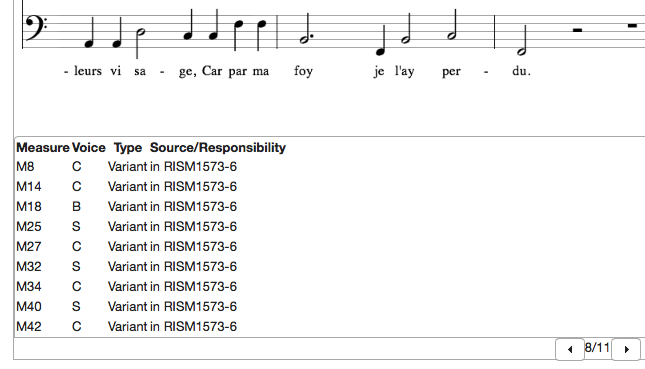
An interactive list of variants and emendations appears in the sidebar. Click the name of a source to show the list of places in the piece where it differs from the base text, or where emendations have been made. Click on a measure and voice number (such as “M32.S”) to go to that location in the viewer.
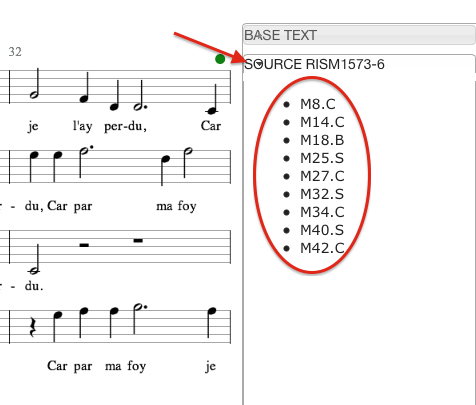
Wherever there is a variant or emendation in the music, a green dot will appear at the end of the measure in the relevant staff. Click on the green dot to summon a popup box that lists the various readings.
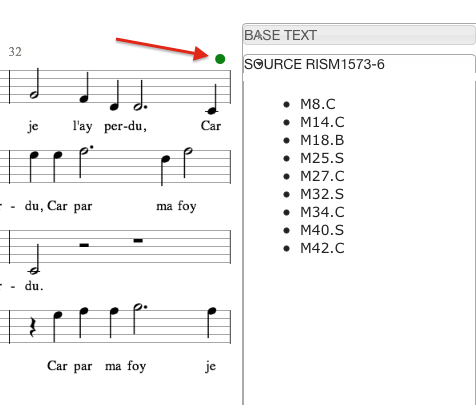
Click on any of the readings to select it.

Click outside the popup box to close it.

If you have selected a different reading, it will remain in the main music area.
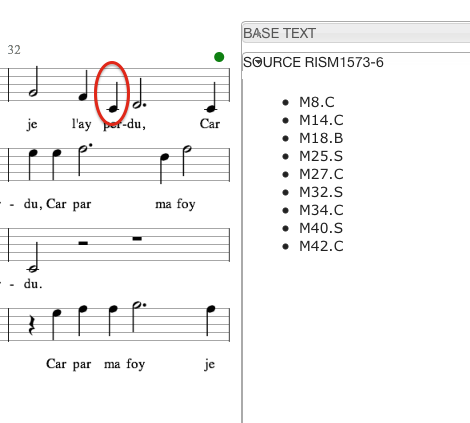
Reconstructions
Approximately 80 of the 120 pieces in books 12 through 16 survive only in two voices (superius and tenor). Our Reconstructions of the contratenor and bassus parts have been crafted using the same controlled vocabulary as was used to build our database of analytic observations. You can see the list of all reconstructions using the link circled in the image below:

Reconstructions can be viewed in the main music area of a piece’s Work View. If a piece has reconstructed parts, this will be mentioned in the sidebar. Click to show the list of reconstructors.

The reconstructions will appear in the same order they do in the sidebar, regardless of the order in which they were clicked.
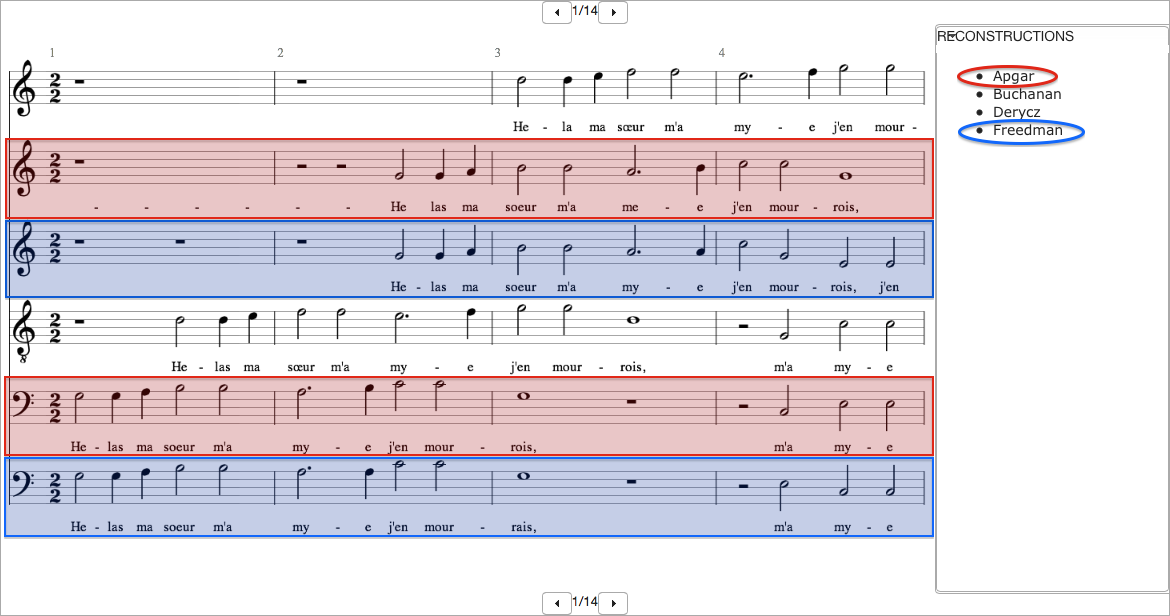
Contact us if you would like to contribute a reconstruction. We can send Sibelius files or engraved PDFs (with empty staves for the contratenor and bassus voices) of any work.
Concordances and Alternate Versions
For some pieces (e.g. DC1315), voice parts may be missing from extant copies of Du Chemin’s work, but present in other sources. When such alternate versions match closely with the surviving voices in Du Chemin’s printing, they are supplied in the same. Concordances function identically to reconstructions in the website’s interface.
A few pieces (e.g. DC1203) have versions surviving in other sources which do not closely match Du Chemin’s printing. In such cases the alternate version is longer than the “canonical” version—it may repeat the final phrase, or may add several measures of unrepeated music. For such pieces, the alternate version is encoded as a distinct piece (e.g. DC1203b). The relationship between the concepts of “piece” and “version” are worth discussing in situations such as these.
Browse
From the Work View you can click on the composer’s name to see a list of the pieces in the Chansons nouvelles by that person.
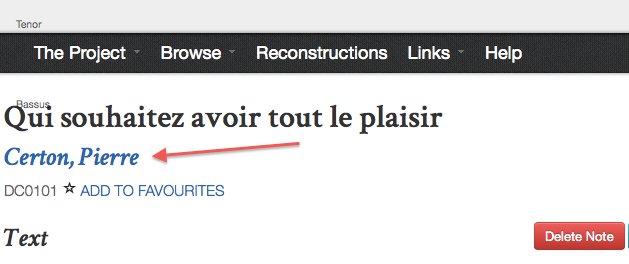
A fuller range of lists can be found via the Browse menu, which offers complete inventories of the sixteen Books (with links to an index of each book), all the Pieces (nearly 400 chansons), People (this list includes both the composers and the modern-day contributors who have analyzed and reconstructed chansons) and all Discussions (for more on these, see below under Accounts From here you can use Work View to explore individual works.
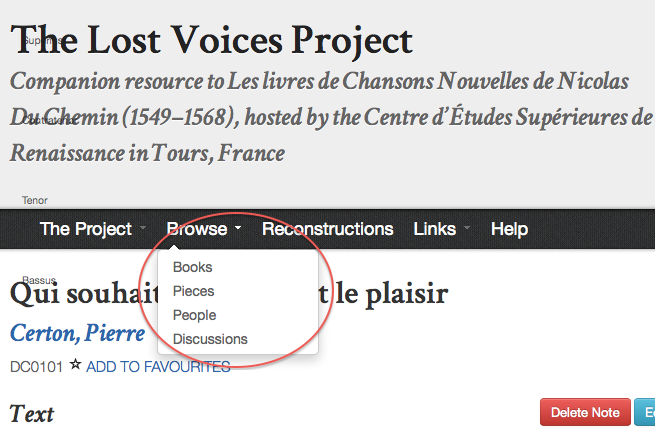
Simple Search
Use the Simple Search box to find music by a given composer, or works containing a particular word (original spellings only). From here you can follow links to individual chansons and their analyses in the Work View.

Advanced Search
Use Advanced Search to limit by composer, book, date, or various analytic patterns as set out in the Controlled Vocabulary and observed by participants in the project. Our engine searches among the observations; it does not search in the music itself.
The main blank area in this Advanced Search page searches in the literary texts.
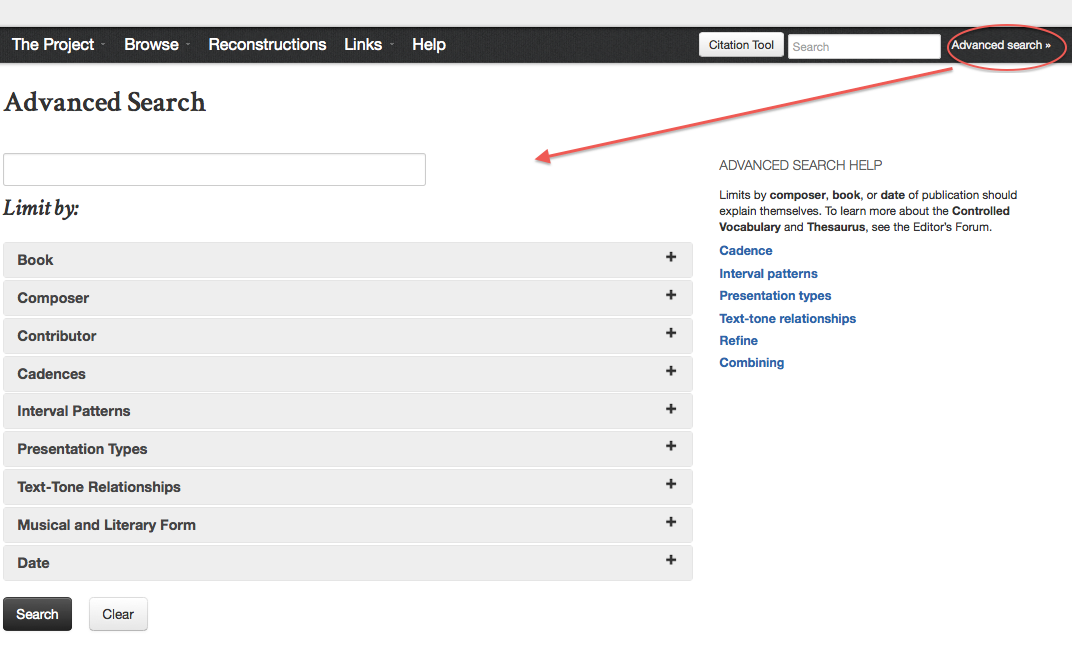
The details of some our controlled vocabulary of cadences, interval patterns, and contrapuntal presentation types can be tricky at first glance. See theAdvanced Search Help page for more information on how to use this interface.
Read more about the Controlled Vocabulary and our methods for analysis and reconstruction in the Thesaurus and Dossier (downloadable in PDF format) via the Editor’s Forum. Here you will find detailed descriptions of cadence types, voice role grids, interval patterns, presentation types, text-tone relationships, and form.
Results: Works and Elements
The Results of an advanced search are presented two ways. This search for works by Claude Martin for instance, returns several compositions.
The Works tab a list of all the pieces that match the criteria. Click on the title to explore each one in the Work View.
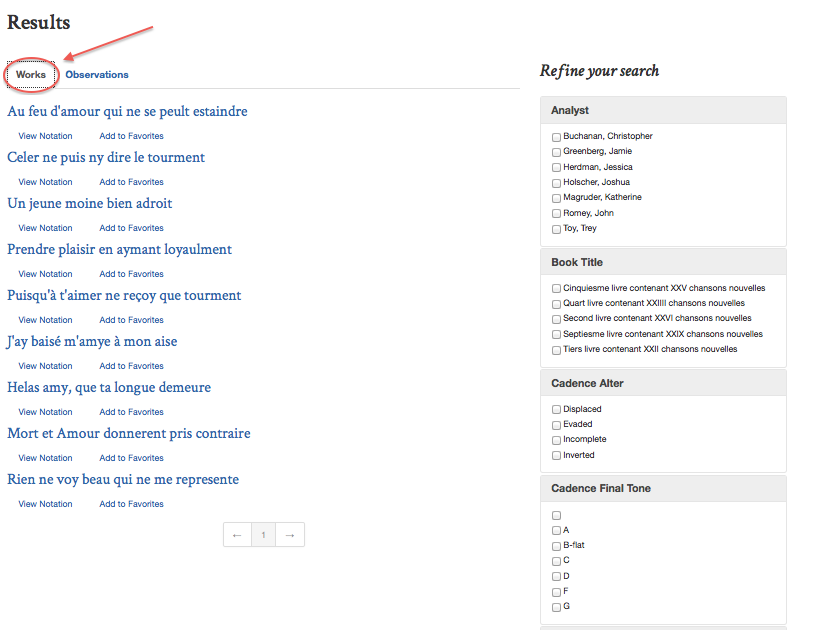
The Observations tab lists the specific passages in these works that match any analytic criteria you have chosen in the previous menu, or via the facets at the right (see under Refine below). Click on the measures to see each passage (often only two or three measures) rendered in modern notation. The Details link provides more information about each observation.
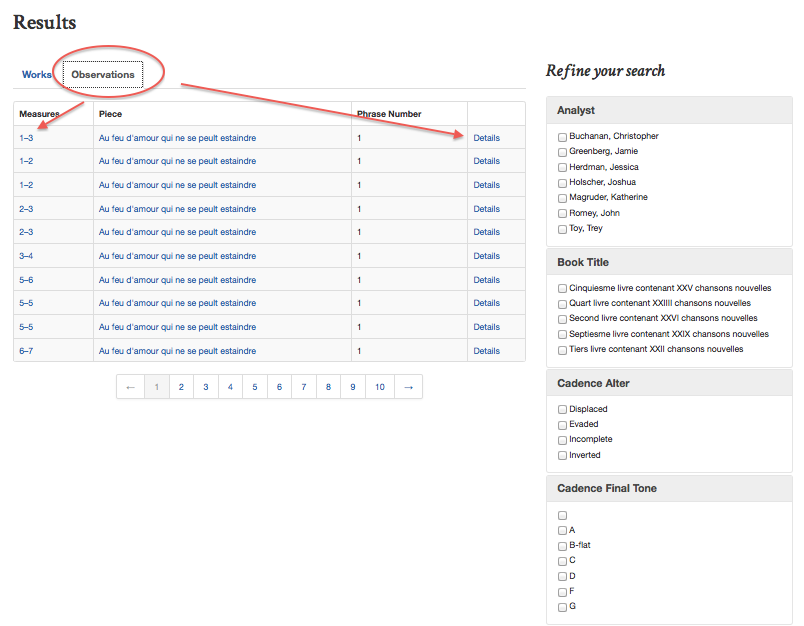
Refine Your Search
Refine or revise your search two ways:
If you have too many results, narrow the search according to the listing of facets provided at the right of the Results page. The results will automatically update to show which remaining pieces satisfy the requested limits. It is also possible to constrain the initial query using any combination of facets on the Advanced Search page (such as Book + Composer + Cadence Tone).
If your results are too few, broaden the search by returning to the Advanced Search page, then review and uncheck various facets. At the bottom of the Advanced Search page, Clear eliminates all limits.

If you are searching for special voice roles, use the voice grids on the Advanced Search page to clear individual roles as needed. See more under Advanced Search Help below.
Account Management
In the sidebar of your profile page, you will find information about your user account, as well as the option to sign out and change your password.
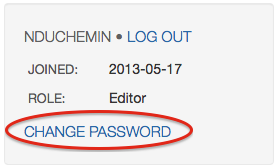
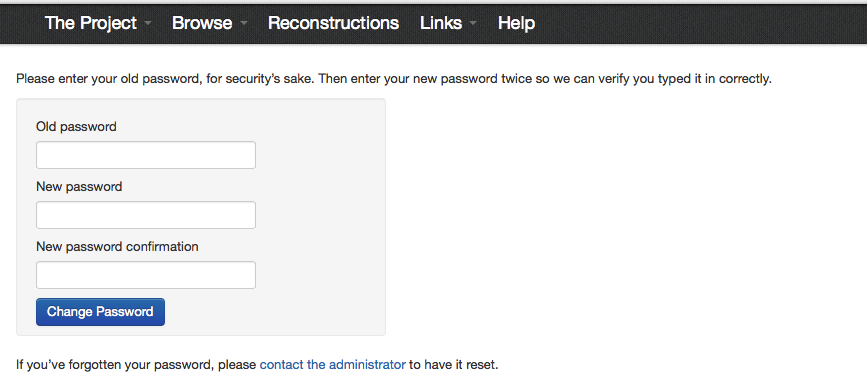
If you do not yet have an account, you can request an account by sending an email to the administrator using the link at the top right corner of the page.

Favourites
In several places throughout the Du Chemin website, there is the option of adding a piece to your list of favourites. When a piece is in the list, it will be marked with a filled star (★). You can add a piece to your favourites from its page:
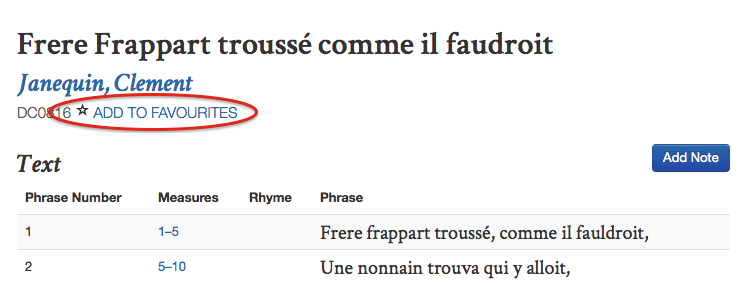
You can also add a piece to your favourites while browsing all pieces:

In the “Favourites” tab on your profile page, you can see all the pieces in your list. From here, you can go to a piece’s Work View, remove a piece from the list, or edit your note on a piece.
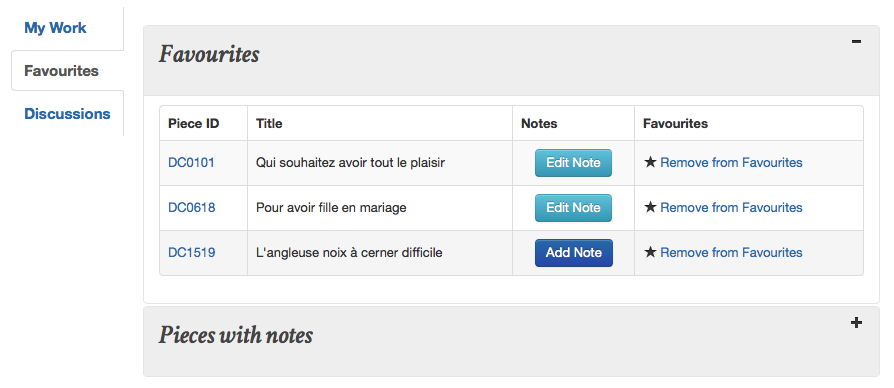
Notes
Notes are a place for you to record thoughts about a piece without making them visible to other viewers. You can add a note directly from the piece view:

If you already have a note on a piece, you will instead see options to delete or edit your note:
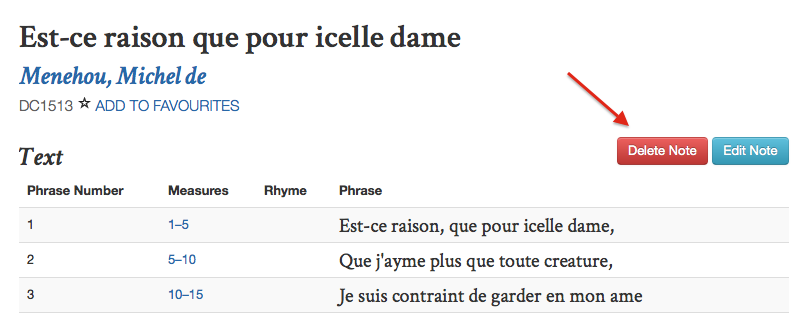

In the “Pieces with Notes” pane, right below your list of favourites, you can see a list of all pieces you have written notes for, whether or not they are in your favourites. From here, you can go to a piece’s Work View, edit or delete your notes, and add or remove a piece from your favourites.

Notes are archived in the site database; if you need to recover an old version of a note that was mistakenly deleted or replaced, you can contact the administrator.
Public Discussions
To discuss the Du Chemin repertoire publicly, you can add a comment to a particular piece. To add a comment to a piece, type your comment in the text area (replacing “Type a comment here”) and click the “Comment” button. Most browsers support resizing the text areaa if it is too small.

If a comment contains the ID of another piece in the repertoire, a link to that piece’s Work View will be created:

On your profile page, you can find a list of all the pieces you have commented on in the “Pieces” pane. Clicking on the link on the Piece ID column brings you to the piece’s Work View. Clicking on “View Discussion” takes you to the piece’s discussion page.
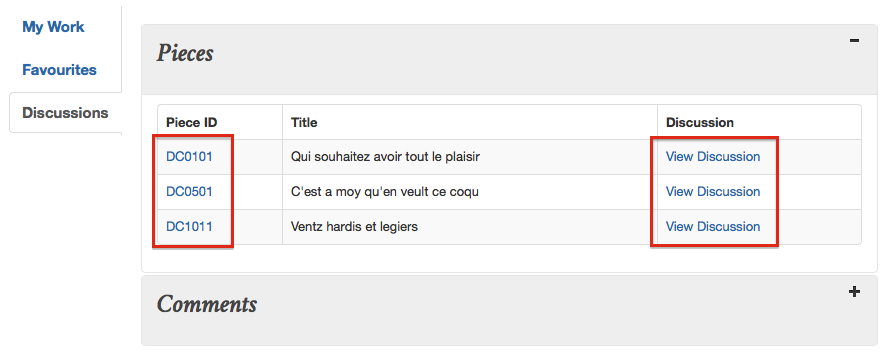
Below, in the “Comments” pane, is a list of all comments you have made on all pieces, sorted by date (with the most recent at the top). Clicking on the text of a comment brings you to the piece’s discussion page.
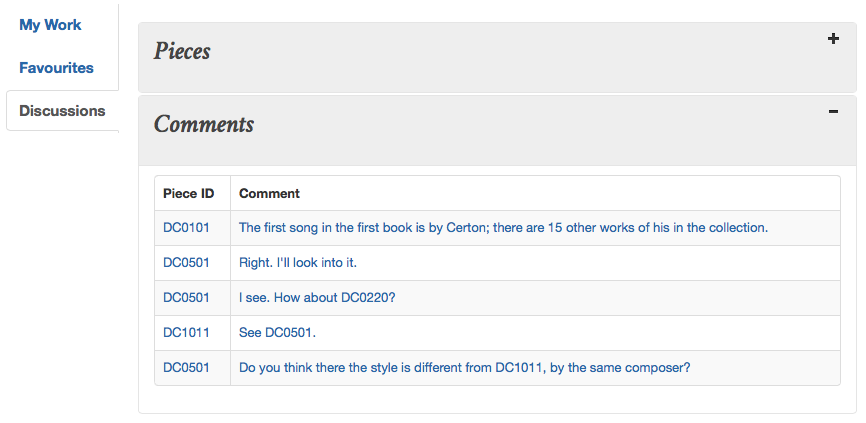
As comments form a public discussion of the Du Chemin repertoire, they can be read by everyone who visits the site; they are also permanent. If you need a comment to be removed for some reason, you should contact the administrator.
Your Public Profile
If your user account is connected to a person in the Du Chemin database, you will find a link to this public page in the upper left corner.
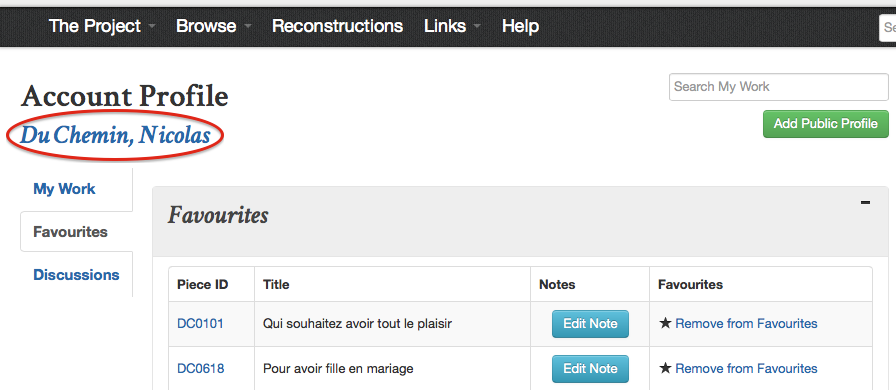
If you have a person page connected with your account, you can edit the public profile that appears on your there directly from your account profile.


Immediately after clicking the “Save Changes” button, your profile will be visible on your associated person page. You can also edit your public profile from this page.

Privacy and Intellectual Property
Your analyses, reconstructions, notes and comments remain your intellectual property. Your name will always remain associated with these ideas; we expect that others citing the resource should ensure to credit them. You nevertheless grant us permission right to publish this work on the Du Chemin Lost Voices web site under a Creative Commons license as described on our web site (derivate works allowed; no commercial use allowed), for electronic scores, sound recordings, and performances.
Any public profile you create can be viewed by anyone, including url's, email addresses, or other identifying information that you choose to include there. Any contributions you make to the public discussions hosted on this site are similarly available for anyone to read.
Private notes made via your account will remain precisely so; they can be viewed only by you. Du Chemin Lost Voices staff will access your private notes only with your written permission. We will not share your account password, email address, or other personal information with anyone. The server system includes safeguards to protect the confidentiality of these data.
Haverford College reserves the right to remove any account or contribution (public or private) at its discretion.
Sharing Results and Citations
Modern Editions, Sound Recordings, and Facsimiles
Each Work View includes links to a complete modern edition (in PDF format) and a sound recording (in MP3 format, with sampled lute sound font in mean-tone temperament). Facsimiles of the original sources can be found via Les chansons nouvelles de Nicolas Du Chemin (CESR), the companion image and edition archive hosted by the CESR in Tours. See Explore Les livres at the top right of any page.
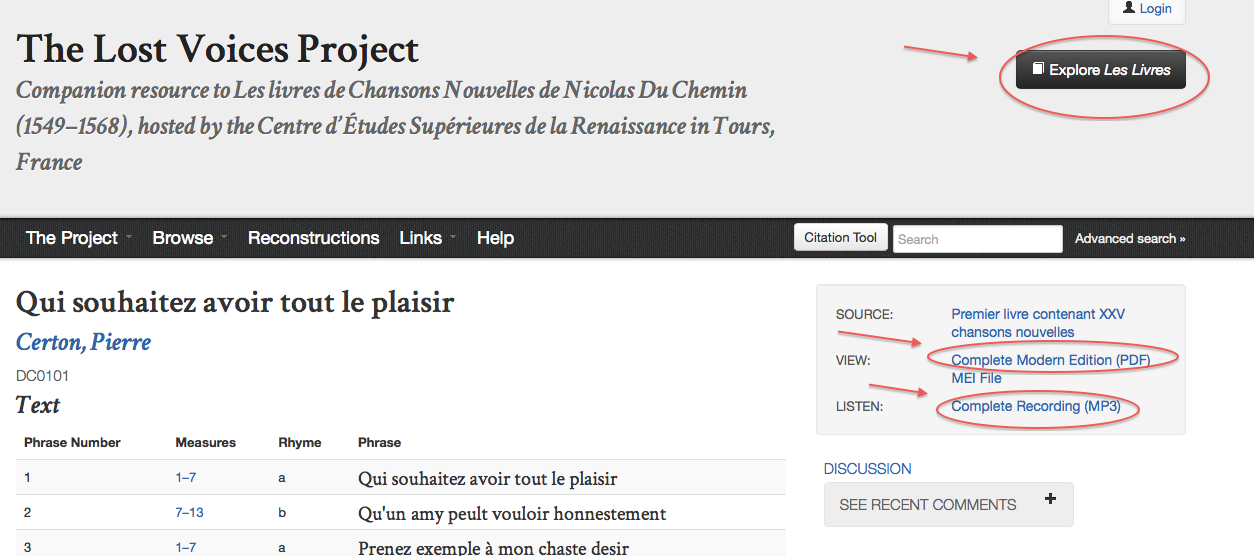
Source Code for MEI Editions
MEI source code for each piece (including markup for variants, emendations, and reconstructions) is available via the link at the right.
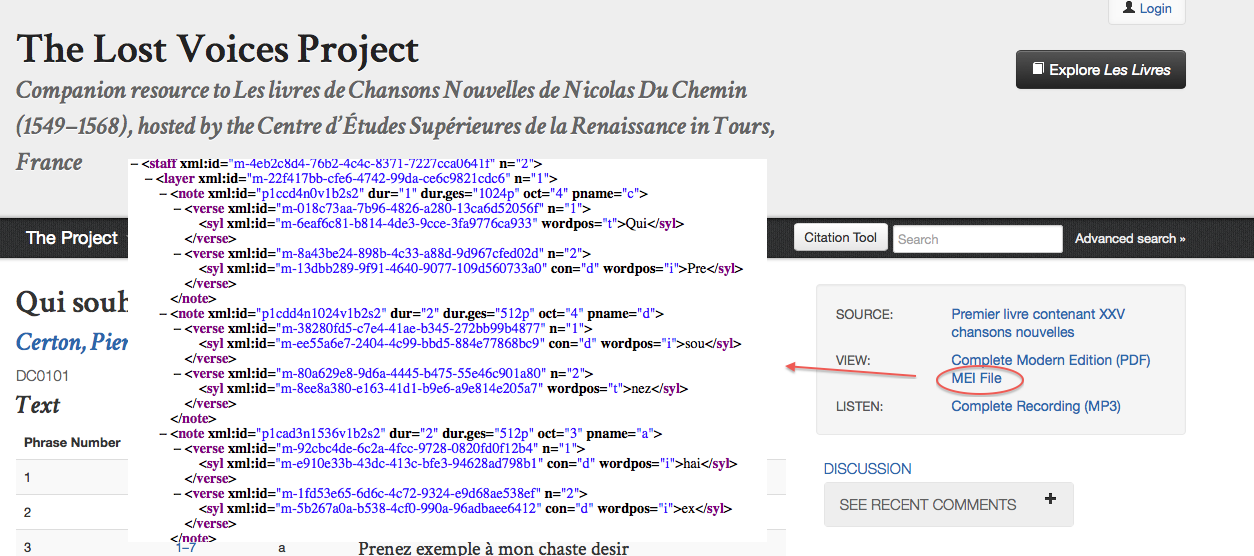
Known Issues
- Editorial accidentals appear somewhat too high above the staff, and can thus at times collide with text in another voice part.
- Changes in mensuration (or time signature) are not rendered in meiView. They are present in the MEI encoding, as well as in the engraved PDF editions.
- Opening repeat signs may not be rendered or encoded properly in meiView. All repeats are fully indicated in the engraved PDF editions.